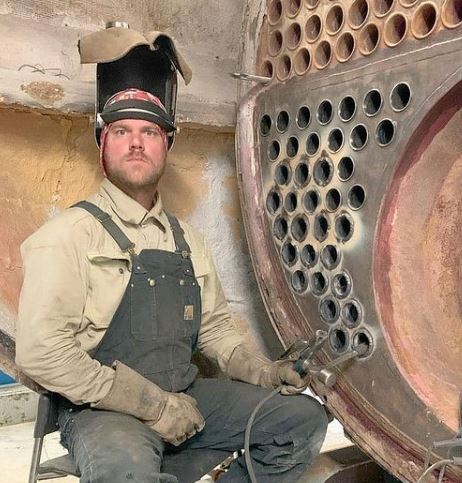Tig welding, also known as tungsten inert gas welding, is a popular choice for aerospace applications due to its ability to produce high-quality, precise welds. It is a specialized form of welding that uses a non-consumable tungsten electrode to produce the weld, and an inert gas, such as argon, to shield the weld area from contamination. Tig welding is often used in the aerospace industry to weld thin materials, such as aluminum and stainless steel, and weld components requiring high accuracy and cleanliness levels.
One of the main advantages of Tig welding is its ability to produce high-quality welds with minimal distortion and little to no spatter. It is also highly versatile and can be used on various materials, including aluminum, stainless steel, and copper alloys. While Tig welding is often considered more challenging to learn and master than other welding methods, it is a valuable skill for many applications, including those in the aerospace industry.

Tig Welding for Aerospace Applications
This beginner’s guide will provide an overview of the tig welding process and its key considerations for aerospace applications.
Tig Welding in Aerospace Applications
In the aerospace industry, Tig welding is used to produce strong, reliable, and precise welds that can withstand the extreme conditions and demands of the environment.
Some common materials and components that are Tig welded in aerospace applications include aircraft fuselages, wing structures, and engine components. These materials often require precise and high-quality welds to ensure the safety and performance of the aircraft.
One of the challenges of Tig welding in the aerospace industry is working with thin materials, which can be difficult to weld without causing distortion or warping. In addition, the aerospace industry often requires welds to be x-rayed or inspected using other non-destructive testing methods to ensure their quality and integrity.
Setting Up for Tig Welding
To set up for Tig welding, you will need a few key pieces of equipment, including a power source, a Tig torch, and a gas cylinder.
It is important to follow proper safety precautions when welding, including wearing appropriate protective gear such as a welding helmet, gloves, and protective clothing.
Choosing the right filler material is also crucial for achieving high-quality welds. In the aerospace industry, aluminum and stainless steel are common filler materials and selecting a filler material compatible with the base metal, and the welding process is important.
Welding Techniques for Aerospace Applications
Before beginning the welding process, it is important to prepare the materials to be welded by cleaning them of any dirt, debris, or oxide layers. This can be done using a grinder or other abrasive tool.
Establishing the correct welding parameters, including the amperage, voltage, and travel speed is crucial for achieving high-quality welds. These parameters will vary depending on the materials being welded and the thickness of the metal.
Several techniques can be used to achieve high-quality Tig welds in aerospace applications, including backstepping, weaving, and pulse. These techniques involve manipulating the torch and filler material in specific ways to produce a strong and aesthetically pleasing weld.
Common Defects in Tig Welding and How to Avoid Them
Porosity: Porosity is a common defect in Tig welds that occurs when small gas pockets become trapped in the weld bead. This can be caused by contamination, inadequate shielding gas coverage, or incorrect welding parameters. To avoid porosity, it is important to use clean materials and ensure that the shielding gas flows properly.
Lack of fusion occurs when the weld bead does not fully fuse to the base metal, leaving a gap or hole in the weld. Improper torch positioning, incorrect welding parameters, or dirty materials can cause this. To prevent a lack of fusion, it is important to ensure that the torch is held at the correct angle and distance from the base metal and to use the correct welding parameters for the welded materials.
Cracks can occur in Tig welds due to excessive heat or stress or because of using inappropriate filler material or welding parameters. To minimize the risk of cracks, it is important to choose the right filler material and pay attention to the preheat and interpass temperatures to avoid overheating the weld.
Warping: Warping is a common issue when welding thin materials, as the heat from the welding process can cause the metal to distort. To minimize the risk of warping, it is important to use the correct welding parameters and techniques, such as backstepping or weaving, to distribute the heat evenly.
Is Tig Stronger Than Mig?
The strength of a weld is determined by various factors, including the materials used, the welding process, the weld joint design, and the quality of the weld. TIG (inert tungsten gas) welding and MIG (inert metal gas) welding can produce strong welds when used correctly. However, the specific strength of a TIG weld compared to a MIG weld will depend on the specific application and the factors mentioned above.
Do Welders Go Blind Over Time?
Welding can produce harmful radiation, including ultraviolet (UV) and infrared (IR) radiation, damaging the eyes and skin if proper precautions are not taken. Welders must wear appropriate personal protective equipment (PPE), such as a welding helmet with a proper lens shade to protect against exposure to these hazards. Prolonged exposure to UV and IR radiation without proper protection can cause eye damage and vision problems. However, with the proper precautions and use of PPE, the risk of vision problems due to welding can be minimized.
Is Tig Welding As Strong As A Stick?
The strength of a TIG (inert tungsten gas) weld can be comparable to that of a stick weld, also known as shielded metal arc welding (SMAW). The specific strength of a TIG weld compared to a stick weld will depend on various factors, including the materials being used, the weld joint design, and the weld quality. In general, both TIG and stick welding can produce strong welds when used correctly.
Is It Better To Tig Weld With Ac Or Dc?
The choice between alternating current (AC) or direct current (DC) for TIG welding depends on the materials being welded and the desired weld characteristics. AC is typically used for welding aluminum, while DC is typically used for welding steel, stainless steel, and other non-ferrous metals. However, there are TIG welding machines capable of producing both AC and DC welding currents, which can be useful for welding various materials.
Can You Weld Everything With A Tig Welder?
TIG (inert tungsten gas) welding can weld various materials, including steel, stainless steel, aluminum, and other non-ferrous metals. However, TIG welding is only suitable for some materials and applications. For example, TIG welding is not typically used for thick welding materials or high-production applications due to the relatively slow welding speed and the need for a skilled operator. TIG welding is best suited for welding thin materials and applications requiring high precision and a high-quality finish.
Conclusion
Tig welding is an essential skill for anyone working in the aerospace industry, as it allows for producing high-quality, reliable welds that are critical for the safety and performance of aircraft.
This beginner’s guide has provided an overview of the basics of Tig welding, including its equipment, techniques, and common defects. By following these guidelines and seeking additional resources and training, aspiring aerospace Tig welders can learn the skills they need to succeed in this challenging and rewarding field.

It’s been years since I got into welding as a side hustle. It’s been so long since Doing All kinds of welds for business and pleasure as this is my hobby. Being in this field I have learned from hands-on-experience also came to know what gears work and what doesn’t. The Tig Welder is my own platform where I use to share my experience.






Leave a Reply